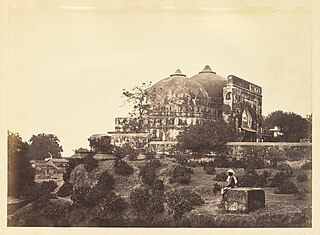
Babri Masjid was a mosque in Ayodhya, India, at a site believed by many Hindus to be the birthplace of Hindu deity Rama. It has been a focus of dispute between the Hindu and Muslim communities since the 18th century. According to the mosque's inscriptions, it was built in 1528–29 by Mir Baqi, a general of the Mughal emperor Babur. The mosque was attacked and demolished by a Hindu nationalist mob in 1992, which ignited communal violence across the Indian subcontinent.

Ilyas is a form of the masculine given name Elias or Elijah.

Mughal architecture is the type of Indo-Islamic architecture developed by the Mughals in the 16th, 17th and 18th centuries throughout the ever-changing extent of their empire in the Indian subcontinent. It developed from the architectural styles of earlier Muslim dynasties in India and from Iranian and Central Asian architectural traditions, particularly Timurid architecture. It also further incorporated and syncretized influences from wider Indian architecture, especially during the reign of Akbar. Mughal buildings have a uniform pattern of structure and character, including large bulbous domes, slender minarets at the corners, massive halls, large vaulted gateways, and delicate ornamentation; examples of the style can be found in modern-day Afghanistan, Bangladesh, India and Pakistan.

Masjid-e-Tooba or Tooba Mosque also known as Gol Masjid, is located in the city of Karachi, Sindh the province of Pakistan. It is situated in the phase 2 of DHA, Karachi.

Panama is a predominantly Christian country, with Islam being a minority religion. Due to secular nature of the Panama's constitution, Muslims are free to proselytize and build places of worship in the country.
Nawan Shehr is a town in Abbottabad District in Khyber Pakthunkhwa of Pakistan. Nawan Shehr's most famous place is Ilyasi Masjid which is the oldest and largest mosque of Abbottabad, there is also a small hill with walking tracks just behind the masjid. The weather is pleasant in summer, so people from other parts of country come to visit Abbottabad and Nawan Shehr. Board of Intermediate and Secondary Education of Abbottabad is also in Nawan Shehr. Nawan Shehr has its own old bazaar which is famous for its Chapli Kebab. The language spoken in Nawanshehr is Hindko. Gojri is also spoken in different parts.
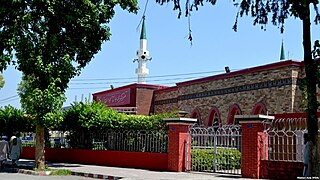
The siege of Lal Masjid was a confrontation in July 2007 between Islamist students & fundamentalist militants and the Government of Pakistan, led by President Pervez Musharraf and Prime Minister Shaukat Aziz. The focal points of the operation were the Lal Masjid and the Jamia Hafsa madrasah complex in Islamabad, Pakistan.

The Lal Masjid is a mosque located in Islamabad, the capital of Pakistan. It is near to Abpara Market, Islamabad. It was constructed in 1966 as one of the oldest mosques in the new capital. It was also the largest mosque in the city for twenty years, until the Faisal Mosque was built in 1986.

Masjid Abdul Hamid Kampong Pasiran, or Abdul Hamid Kampong Pasiran Mosque is a mosque in Novena, Singapore. Built in 1932 in an area then known as Kampong Pasiran to replace a surau, it serves the needs of office workers around Newton and Novena. Before April 2002, it had a capacity of about 300 people. The mosque was demolished, rebuilt, and reopened on 24 October 2022. The new mosque building, built at a cost of $2 million, has a capacity of 600 people.
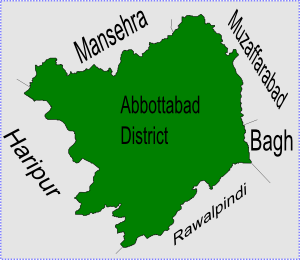
Nawansher Urban is one of the 51 union councils of Abbottabad District in Khyber-Pakhtunkhwa province of Pakistan. It is located in the north of the district. It is one of the oldest settlements in Abbottabad district.

Moti Masjid, one of the "Pearl Mosques", is a 17th-century religious building located inside the Lahore Fort, Lahore, Punjab, Pakistan. It is a small, white marble structure built by Mughal emperor Jahangir and modified by the architects of Shah Jahan, and is among his prominent extensions to the Lahore Fort Complex. The mosque is located on the western side of Lahore Fort, closer to Alamgiri Gate, the main entrance.
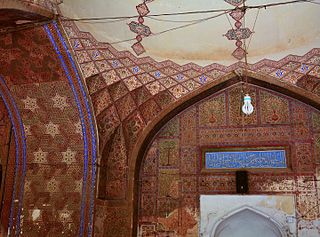
Begum Shahi Mosque, officially The Mosque ofMariyam Zamani Begum, is an early 17th-century mosque situated in the Walled City of Lahore, Punjab, Pakistan. Constructed by Mughal Empress Mariam-uz-Zamani, chief consort of Emperor Akbar, it is one of the largest mosques in Pakistan. The mosque was built between 1611 and 1614 during the reign of Mughal Emperor Jahangir.

The Aqsa Mosque is the largest mosque of the Ahmadiyya Muslim Community in Pakistan. Its foundation stone was laid down in 1966. The mosque was inaugurated on March 31, 1972 by the head of the worldwide Community, Mirza Nasir Ahmad. This is the main mosque of the Ahmadiyya Muslim Community in Rabwah which can accommodate up to 20,000 worshippers.

The Badshahi Mosque is a Mughal-era congregational mosque in Lahore, capital of the Pakistani province of Punjab. The mosque is located west of Lahore Fort along the outskirts of the Walled City of Lahore, and is widely considered to be one of Lahore's most iconic landmarks.
Shaheed Ganj Mosque, originally named the Abdullah Khan Mosque, was a mosque in Lahore, Punjab, Pakistan. The Mosque was commissioned in 1722 during the reign of Mughal Emperor Muhammad Shah and built by Abdullah Khan construction was completed in 1753 during the reign of Ahmad Shah Bahadur. It was constructed next to the shrine of Pir Shah Kaku. Sikh rule began in 1762, the Gurdwara Bhai Taru Singh was built afterwards within the same grounds. The mosque site was under dispute during British rule, but was demolished by Sikhs on the night of 8 July 1935.

Jarral is one of the 57 union councils of Abbottabad District in the Khyber Pakhtunkhwa province of Pakistan.

Grand Jamia Mosque, is a cultural complex under construction in Bahria Town Karachi, Pakistan. When completed, the complex will include what would be Pakistan's largest and the world's third-largest mosque according to capacity. The mosque will be able to accommodate 800,000 worshippers at a time.
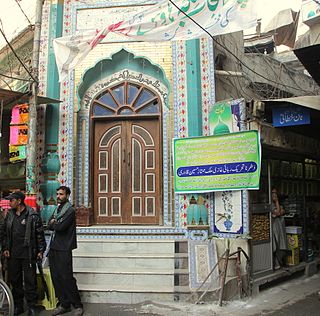
Saleh Kamboh Mosque is a mosque located in Lahore in the Pakistani province of Punjab. The mosque was built by Muhammad Saleh Kamboh, a court historian during the reign of Mughal emperor Shah Jahan. Although the mosque was built during the reign of Aurangzeb, it includes features of Shahjahani architecture.

The New Memon Masjid known as the Memon Masjid is a mosque located in Karachi, Pakistan. It is one of the largest and oldest mosques in the city.

















